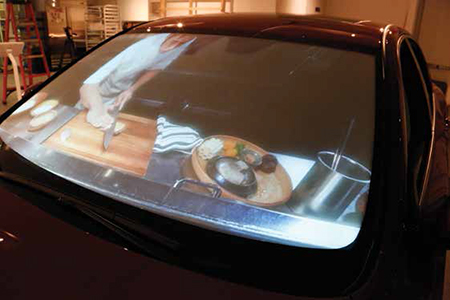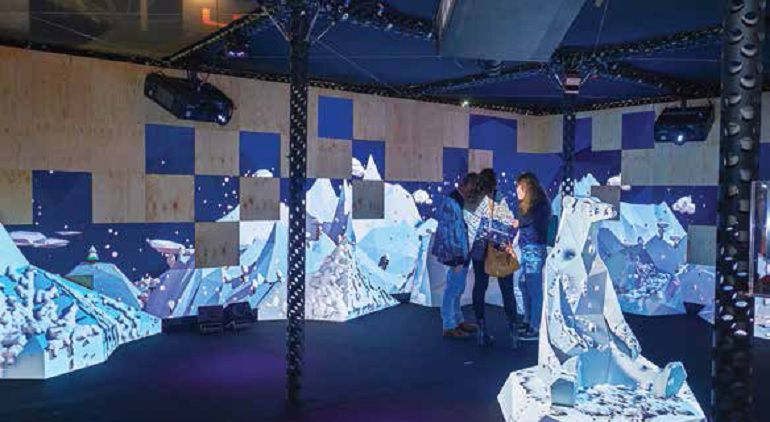Who said maps can’t grow? Projection mapping is maturing beyond large-scale, big-budget applications and rapidly expanding its borders, reaching into sports, entertainment, and corporate markets.
Of course, the grandiose events such as the Super Bowl and the Olympics opening ceremony using this technology are spectacular. “But let’s talk about using mapping for localized, specific impact such as the local car dealership with a location visible from the highway, attracting attention for a new model release,” noted Michael Bridwell, vice president, marketing and home entertainment, Digital Projection Inc. “Or the trade show exhibit with mapping used to guide attendees through the floor plan, highlighting key aspects through visual cues.”
Even a museum on a tight budget can create an interactive learning environment with numerous scenes, using a few bright projectors already in their facility. “I’ve seen plays and advertising stunts, etc., presenting incredibly immersive mapped experiences just by projecting on large, painted boxes arranged and rearranged to reveal surprisingly original projection surfaces,” he added. “From a warp and blend scenario, DPI’s Projector Controller allows for the easy management of multiple projectors through a simple external application. Warp and blend, as well as diagnostics, illumination monitoring, and more are managed through this powerful add-on.”
The point is, Bridwell said, that the true advantage of high-powered projectors is their ability to deliver scale. “If you’re lucky enough to have one or more of these tools in your arsenal, use them to full effect. Light up the side of your building, create a space in your office that will catch the attention of customers. Simple mapping spaces can be extremely powerful.”
Map to Sell
Although projection mapping is nothing new in the themed entertainment market, its expansion continues with themed attractions combining the use of physical props along with curved screens and high-resolution, high-frame-rate content, said Scott Harkless, director of sales, Alcorn McBride. “The most important parts of selling into this environment are industry focus and relationships. You have to understand the complexity and attention to detail required to pull off these world-class attractions, and you have to be sensitive to the fact that the playback and projection equipment will need to operate all day, every day, for many years. This means having a close relationship with the engineering and maintenance staff and respecting their needs.”

All of it Now, a San Francisco based creative projection agency uses Epson high lumen projectors to create unique projection mapping installations on buildings, landscapes, car windshields, and more. And selling into both the sports and corporate activation spaces has environmental challenges that require additional considerations when compared to projection mapping in more traditional markets, noted Danny Firpo, managing partner, All of It Now, an Epson solutions partner. “Sporting events, performing arts, fashion, and automotive are among the types of activations and special events that require a unique display for presentation,” he said. “The flexibility of projection mapping allows for integration of stunning visual effects with an existing projection surface to produce an unconventional ‘wow’ factor. Customizable solutions are expanding integration capabilities and creating new possibilities, such as motion-tracked performances and a variety of digital marketing activations.”
Specifically, he said, activations enabling customer engagement create longer lasting impressions, translating to higher engagement on social media, extending the project beyond the immediate physical space into the social media realm. Yet designing and working around constraints like ambient light, fixed structures, branded elements, and building weight limitations can require the projection team to engineer some creative solutions.
“Higher lumen output projectors, professional mapping features, and smaller form-factor design are contributing significantly to growth in new markets,” Firpo added. “Epson’s Pro Z-Series and L-Series projectors are perfect products for multiple projector edge blends, due to the high lumen output, color brightness, and number of production friendly features packed into an affordable price point.”
The 3D workflow of projecting onto a physical object is a new challenge to those familiar with traditional LED and LCD displays. “Adding the third dimension greatly increases project difficulty and complexity in both the content creation and production,” he explained. “Accuracy of pre-production planning and calculations become a crucial factor in ease of final execution and installation quality.”
A wide array of skills are necessary for successful projection mapping; a few key areas include intelligent creative design, 3D modeling, motion graphics, video production, and information technology. “Because projection mapping projects involve so many fields of knowledge, a cohesive, multidisciplinary team is a must,” Firpo said. “Because of the social engagement inherent in these installations, designing a project for engaging social media introduces other challenges. The project needs to be designed to not only attract users on-site, but also needs to translate well on camera, requiring the design team to balance lighting elements and exterior conditions while still providing an exciting environment for the user.”
Getting the Edge
With the recent advances in the warping and blending technologies natively built into projectors, we’re now able to achieve much cleaner blends, noted Harkless. “This is because the precision of the image processor in the project exceeds the precision that can be achieved over interconnects like HDMI, DP, and DVI. Furthermore, these hardware blending systems work well with camera alignment systems, so it’s much easier to create and maintain nice blends.”
Although software blending is quicker to implement, blending in hardware is more precise and allows you to use significantly more reliable playback systems, he added. “Generally, software blending is achieved by PC servers, which are not ideal for the abuse and longevity required by themed attractions. With hardware blending in the projector, you can utilize solid-state playback systems that were purpose-built for these types of applications.”
Edge blending has come a long way in the past decade, expanding beyond single plane 2D blends, to complex 3D blends on curved surfaces and dimensional elements, Firpo said. “These advancements have simultaneously created new possibilities and new challenges for mapping surfaces. 3D blending solutions feature a true 3D modeling workflow from planning to execution. In addition, 3D scanning technology has developed into a production ready solution from a previously experimental process. This method leverages IR and 3D depth mapping technologies to simplify complex multi-plane mapping and blending, opening the door for exciting mapping possibilities.”
What once took days to calibrate and align on-site can now be done in a matter of hours or even minutes with proper 3D pre-visualization. “The calibration time is migrated into the 3D modeling and planning phase, which significantly reduces overall installation time,” he added. “This is especially advantageous on projects that require high venue and labor costs or significant travel time, minimizing the duration of equipment rental and staffing.”
When determining whether to go with hardware versus software options, the most important consideration is the projection surface. “Hardware blending works best in projections utilizing a single plane or fixed curvature surfaces,” Firpo said. “The projector’s built-in image warping engine will often produce better results than software solutions, which typically create pixel distortion upstream of the projector’s output.
“A software blending solution works best with complex blends where the surface does not have a fixed plane or fixed angle curvature. In this situation, pixel distortion is less of a factor, as the image is already being distorted by the surface itself. Availability of a 3D model is also a significant factor in pursuing a software approach. Edge blending across a complex, multi-dimensional surface can be efficiently calculated and performed via software in situations where hardware edge blending is not an option.”
The bottom line for integrators and their customers? “Don’t sacrifice the reliability and longevity of an attraction just to save a little time during installation,” Harkless advised. “Invest in projection and mapping systems that will make daily alignment easy and invest in projection and playback hardware that will withstand the abuse of daily use for many years.”
Karen Mitchell is a freelance writer based in Boulder, CO.
No Pitfalls Here
Avoiding the biggest pitfalls when designing, integrating, and maintaining mapped projects has several aspects, among them projector positioning, Firpo said. “If the projector is placed incorrectly, extruding faces on the surface can create silhouettes in the projection. If projecting from above, avoid using extruding faces that can block other surfaces below. Use projector specifications to review mounting hardware and lensing limitations, as improper planning can result in a show-stopping failure. Projection throw calculation and the production engineering process becomes extremely important in placement design.”
Isolating the structure from vibration or shock is an important factor in the maintenance phase of both large-and small-scale projects, he noted. “The structure can be moved out of alignment from the original mapping over time by vibration from a nearby sound system, or from users walking near the object when it is not isolated from the surrounding floor.”
When it comes to content creation and selection, remember that content can translate very differently to a structure once it is projected, when compared to the appearance on a monitor screen, Firpo said. “The scale of the structure plays an important role in how the content appears on the structure. Fast-moving content that initially was appropriate on a monitor can become jarring or disorienting when scaled up to an immense size.”
Deciding how to use negative and positive space in a content project is often a matter of aesthetic choice or branding requirements, but makes a huge difference in the conceptual realization of the project, he explained.
A more technical piece of the puzzle is signal flow and latency. “Maintaining a consistent signal flow across all projectors will ensure that multiple output projects stay synced across all projectors,” Firpo concluded. “A common pitfall is losing sync between outputs by introducing an additional device in the signal flow, or adding keystoning or scaling that is not added consistently across all projectors.
“Finally, selecting a flexible mapping software allows the designer to add final touch-ups, and perform periodic tweaks if needed. The ability to dynamically adjust frame delay, edge masking, and output mapping guarantees that even if external factors compromise system integrity, the system is flexible enough to accommodate these changes.”
—K.M.
